Temperature Dependency on the Microscopic Mechanism in the Normal Direction of Wrought AZ31 Sheet under Dynamic Compressive Behavior
Abstract
:1. Introduction
2. Experimental
2.1. Experimental Material
2.2. Experimental Method
3. Results
3.1. Mechanical Responses
3.2. Microstructure
4. Discussion
4.1. Activation of the Deformation Mechanism
4.2. Dynamic Recrystallization
5. Conclusions
- (1)
- During the high-temperature dynamic deformation, the c-axis of grains is gradually reoriented parallel to the normal direction of the wrought AZ31-ND sheet with the temperature increasing, except the DRX mechanism is activated or grains grow up, which is completely beneficial for tension twinning activation.
- (2)
- At lower temperatures (≤250 °C), when the loading direction is parallel to the c-axis of the grains, the pyramidal <a> and <c+a> slip are the particularly predominant deformation mechanism. At higher temperatures (≥250 °C), tension twinning is the predominant deformation mechanism. Otherwise, the predominant type of the DRX mechanism of the wrought AZ31-ND sheet is RDRX.
- (3)
- The kernel misorientation concentration regions are always enhanced by deformed grains, especially by tension twins, but weakened by substructure grains and DRX grains.
Author Contributions
Funding
Institutional Review Board Statement
Informed Consent Statement
Data Availability Statement
Conflicts of Interest
References
- Pollock, T.M. Weight Loss with Magnesium Alloys. Science 2010, 328, 986–987. [Google Scholar] [CrossRef]
- Zhang, F.; Liu, Z.; Wang, Y.; Mao, P.; Kuang, X.; Zhang, Z.; Ju, Y.; Xu, X. The modified temperature term on Johnson-Cook constitutive model of AZ31 magnesium alloy with {0002} texture. J. Magnes. Alloys 2020, 8, 172–183. [Google Scholar] [CrossRef]
- Wu, Z.; Curtin, W.A. The origins of high hardening and low ductility in magnesium. Nat. Cell Biol. 2015, 526, 62–67. [Google Scholar] [CrossRef] [PubMed] [Green Version]
- Wang, X.; Mao, P.; Liu, Z.; Wang, Z.; Wang, F.; Zhou, L.; Wei, Z. Nucleation and growth analysis of {101‾2} extension twins in AZ31 magnesium alloy during in-situ tension. J. Alloys Compd. 2020, 817, 152967. [Google Scholar] [CrossRef]
- Zhang, F.; Liu, Z.; Yang, M.; Su, G.; Zhao, R.; Mao, P.; Wang, F.; Sun, S. Microscopic mechanism exploration and constitutive equation construction for compression characteristics of AZ31-TD magnesium alloy at high strain rate. Mater. Sci. Eng. A 2020, 771, 138571. [Google Scholar] [CrossRef]
- Zhang, W.; Liu, S.; Li, K.; Li, P.; Qi, J.; Wang, Z.; Chen, Y.; Zhang, H.; Meng, L. High strain-rate behavior and deformation mechanism of a multi-layer composite textured AZ31B Mg alloy plate. J. Alloys Compd. 2018, 749, 23–39. [Google Scholar] [CrossRef] [Green Version]
- Wang, W.; Chen, W.; Zhang, W.; Cui, G.; Wang, E. Weakened anisotropy of mechanical properties in rolled ZK60 magnesium alloy sheets with elevated deformation temperature. J. Mater. Sci. Technol. 2018, 34, 2042–2050. [Google Scholar] [CrossRef]
- Chen, X.; Wang, L.; Xiao, R.; Zhong, X.Y.; Huang, G.; Liu, Q. Comparison of annealing on microstructure and anisotropy of magnesium alloy AZ31 sheets processed by three different routes. J. Alloys Compd. 2014, 604, 112–116. [Google Scholar] [CrossRef]
- Jiang, M.; Xu, C.; Yan, H.; Fan, G.; Nakata, T.; Lao, C.; Chen, R.; Kamado, S.; Han, E.; Lu, B. Unveiling the formation of basal texture variations based on twinning and dynamic recrystallization in AZ31 magnesium alloy during extrusion. Acta Mater. 2018, 157, 53–71. [Google Scholar] [CrossRef]
- Hyun, C.S.; Kim, M.S.; Choi, S.H.; Shin, K.S. Crystal plasticity FEM study of twinning and slip in a Mg single crystal by Erichsen test. Acta Mater. 2018, 156, 342–355. [Google Scholar] [CrossRef]
- Cepeda-Jiménez, C.; Castillo-Rodríguez, M.; Pérez-Prado, M. Origin of the low precipitation hardening in magnesium alloys. Acta Mater. 2019, 165, 164–176. [Google Scholar] [CrossRef]
- Liu, Y.; Mao, P.; Zhang, F.; Liu, Z.; Wang, Z. Effect of temperature on the anisotropy of AZ31 magnesium alloy rolling sheet under high strain rate deformation. Philos. Mag. 2018, 98, 1068–1086. [Google Scholar] [CrossRef]
- Wong, T.W.; Hadadzadeh, A.; Wells, M.A. High temperature deformation behavior of extruded AZ31B magnesium alloy. J. Mater. Process. Technol. 2018, 251, 360–368. [Google Scholar] [CrossRef]
- Chapuis, A.; Liu, Q. Investigating the temperature dependency of plastic deformation in a Mg-3Al-1Zn alloy. Mater. Sci. Eng. A 2018, 725, 108–118. [Google Scholar] [CrossRef]
- Wan, G.; Wu, B.; Zhang, Y.; Sha, G.; Esling, C. Anisotropy of dynamic behavior of extruded AZ31 magnesium alloy. Mater. Sci. Eng. A 2010, 527, 2915–2924. [Google Scholar] [CrossRef]
- Pan, H.; Wang, F.; Feng, M.; Jin, L.; Dong, J.; Wu, P. Mechanical behavior and microstructural evolution in rolled Mg-3Al-1Zn-0.5Mn alloy under large strain simple shear. Mater. Sci. Eng. A 2018, 712, 585–591. [Google Scholar] [CrossRef]
- Knezevic, M.; Levinson, A.; Harris, R.; Mishra, R.K.; Doherty, R.D.; Kalidindi, S.R. Deformation twinning in AZ31: Influence on strain hardening and texture evolution. Acta Mater. 2010, 58, 6230–6242. [Google Scholar] [CrossRef]
- Ulacia, I.; Dudamell, N.; Galvez, F.; Yi, S.; Pérez-Prado, M.; Hurtado, I. Mechanical behavior and microstructural evolution of a Mg AZ31 sheet at dynamic strain rates. Acta Mater. 2010, 58, 2988–2998. [Google Scholar] [CrossRef]
- Dudamell, N.; Ulacia, I.; Galvez, F.; Yi, S.; Bohlen, J.; Letzig, D.; Hurtado, I.; Pérez-Prado, M. Twinning and grain subdivision during dynamic deformation of a Mg AZ31 sheet alloy at room temperature. Acta Mater. 2011, 59, 6949–6962. [Google Scholar] [CrossRef] [Green Version]
- Sitdikov, O.; Kaibyshev, R. Dynamic Recrystallization in Pure Magnesium. Mater. Trans. 2001, 42, 1928–1937. [Google Scholar] [CrossRef] [Green Version]
- Liu, X.; Zhu, B.W.; Xie, C.; Zhang, J.; Tang, C.P.; Chen, Y.Q. Twinning, dynamic recrystallization, and crack in AZ31 magnesi-um alloy during high strain rate plane strain compression across a wide temperature. Mater. Sci. Eng. A 2018, 733, 98–107. [Google Scholar] [CrossRef]
- Niu, Y.; Le, Q.; Ning, F.; Hou, J.; Jia, Y. Strain induced dynamic recrystallization nucleation of ZA21 magnesium alloy during compression process at low and medium temperatures. J. Mater. Res. Technol. 2020, 9, 340–346. [Google Scholar] [CrossRef]
- Singh, J.; Kim, M.-S.; Kaushik, L.; Kang, J.-H.; Kim, D.; Martin, E.; Choi, S.-H. Twinning-detwinning behavior of E-form Mg alloy sheets during in-plane reverse loading. Int. J. Plast. 2020, 127, 102637. [Google Scholar] [CrossRef]
- Williams, C.L.; Kale, C.; Turnage, S.A.; Shannahan, L.S.; Li, B.; Solanki, K.N.; Becker, R.; Hufnagel, T.C.; Ramesh, K.T. Real-time observation of twinning-detwinning in shock-compressed magnesium via time-resolved in situ synchrotron XRD experiments. Phys. Rev. Mater. 2020, 4, 083603. [Google Scholar] [CrossRef]
- Feng, F.; Huang, S.; Meng, Z.; Hu, J.; Lei, Y.; Zhou, M.; Yang, Z. A constitutive and fracture model for AZ31B magnesium alloy in the tensile state. Mater. Sci. Eng. A 2014, 594, 334–343. [Google Scholar] [CrossRef]
- Gao, C.Y.; Zhang, L.C.; Guo, W.G.; Li, Y.L.; Lu, W.R.; Ke, Y.L. Dynamic plasticity of AZ31 magnesium alloy: Experimental in-vestigation and constitutive modeling. Mater. Sci. Eng. A 2014, 613, 379–389. [Google Scholar] [CrossRef]
- Cheng, J.; Shen, J.; Mishra, R.K.; Ghosh, S. Discrete twin evolution in Mg alloys using a novel crystal plasticity finite element model. Acta Mater. 2018, 149, 142–153. [Google Scholar] [CrossRef]
- Chen, S.-F.; Song, H.-W.; Zhang, S.-H.; Cheng, M.; Zheng, C.; Lee, M.-G. An effective Schmid factor in consideration of combined normal and shear stresses for slip/twin variant selection of Mg-3Al-1Zn alloy. Scr. Mater. 2019, 167, 51–55. [Google Scholar] [CrossRef]
- Bajargan, G.; Singh, G.; Sivakumar, D.; Ramamurty, U. Effect of temperature and strain rate on the deformation behavior and microstructure of a homogenized AZ31 magnesium alloy. Mater. Sci. Eng. A 2013, 579, 26–34. [Google Scholar] [CrossRef]
- Molodov, K.D.; Al-Samman, T.; Molodov, D.A.; Gottstein, G. On the Ductility of Magnesium Single Crystals at Ambient Temperature. Metall. Mater. Trans. A 2014, 8, 3275–3281. [Google Scholar] [CrossRef]
- Wang, X.; Mao, P.; Wang, R.; Liu, Z.; Wang, Z.; Wang, F.; Zhou, L.; Wei, Z. Role of {101‾2} twinning in the anisotropy and asymmetry of AZ31 magnesium alloy under high strain rate deformation. Mater. Sci. Eng. A 2020, 772, 138814. [Google Scholar] [CrossRef]
- Nan, X.-L.; Wang, H.-Y.; Zhang, L.; Li, J.-B.; Jiang, Q.-C. Calculation of Schmid factors in magnesium: Analysis of deformation behaviors. Scr. Mater. 2012, 67, 443–446. [Google Scholar] [CrossRef]
- Lou, X.; Li, M.; Boger, R.; Agnew, S.; Wagoner, R. Hardening evolution of AZ31B Mg sheet. Int. J. Plast. 2007, 23, 44–86. [Google Scholar] [CrossRef]
- Wan, G.; Wu, B.; Zhao, Y.; Zhang, Y.; Esling, C. Strain-rate sensitivity of textured Mg–3.0Al–1.0Zn alloy (AZ31) under impact deformation. Scr. Mater. 2011, 65, 461–464. [Google Scholar] [CrossRef]
- Chapuis, A.; Liu, Q. Modeling strain rate sensitivity and high temperature deformation of Mg-3Al-1Zn alloy. J. Magnes. Alloy. 2019, 7, 433–443. [Google Scholar] [CrossRef]
- Liu, X.; Jonas, J.; Li, L.; Zhu, B. Flow softening, twinning and dynamic recrystallization in AZ31 magnesium. Mater. Sci. Eng. A 2013, 583, 242–253. [Google Scholar] [CrossRef]
- Srinivasarao, B.; Dudamell, N.; Perez-Prado, M.T. Texture analysis of the effect of non-basal slip systems on the dynamic recrystallization of the Mg alloy AZ31. Mater. Charact. 2013, 75, 101–107. [Google Scholar] [CrossRef]
- Tang, W.; Liu, S.; Liu, Z.; Kang, S.; Mao, P.; Guo, H. High strain rate compression deformation mechanism and constitutive equation of fine grained Mg-7Gd-5Y-1.2Nd-0.5Zr alloy at different temperatures. Mater. Sci. Eng. A 2020, 780, 139208. [Google Scholar] [CrossRef]
- Wu, Y.; Zhu, R. Effect of Rolling Temperature on the Microstructure and Mechanical Properties of AZ31 Alloy Sheet Processed through Variable-Plane Rolling. J. Mater. Eng. Perform. 2019, 28, 6182–6191. [Google Scholar] [CrossRef]
- Zhu, B.; Liu, X.; Xie, C.; Wu, Y.; Zhang, J. {10–12} extension twin variant selection under a high train rate in AZ31 magnesium alloy during the plane strain compression. Vacuum 2019, 160, 279–285. [Google Scholar] [CrossRef]
- Jiang, L.; Jonas, J.; Mishra, R.; Luo, A.; Sachdev, A.; Godet, S. Twinning and texture development in two Mg alloys subjected to loading along three different strain paths. Acta Mater. 2007, 55, 3899–3910. [Google Scholar] [CrossRef]
- Kim, H.; Lee, J.-H.; Lee, C.; Bang, W.; Ahn, S.; Chang, Y. Shear band formation during hot compression of AZ31 Mg alloy sheets. Mater. Sci. Eng. A 2012, 558, 431–438. [Google Scholar] [CrossRef]
- Yang, M.; Zhang, F.; Yu, W.; Bai, Y.; Liu, Z. Microstructural Characteristics and Subsequent Soften Mechanical Response in Transverse Direction of Wrought AZ31 with Elevated Compression Temperature. Materials 2021, 14, 4055. [Google Scholar] [CrossRef] [PubMed]


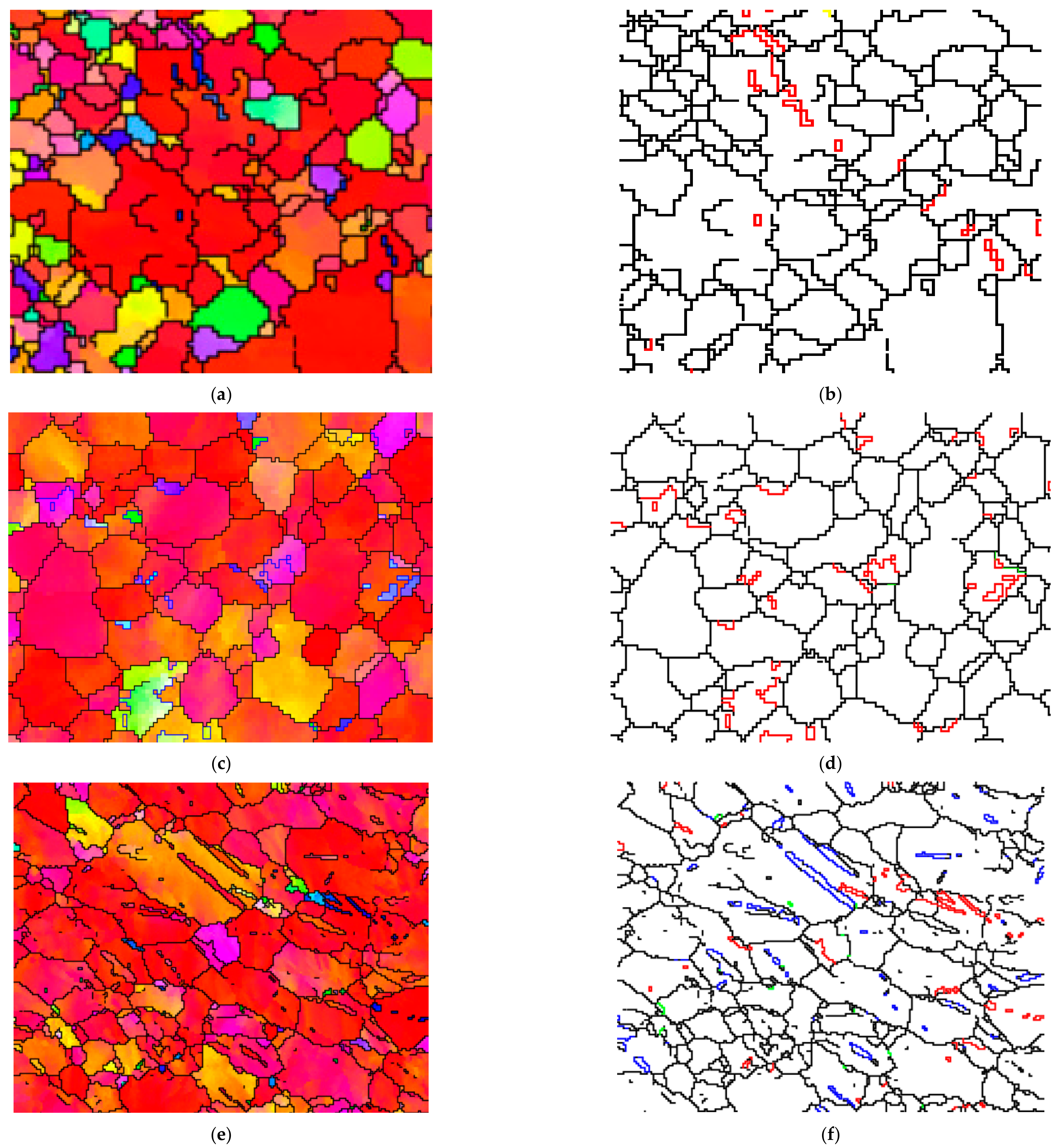
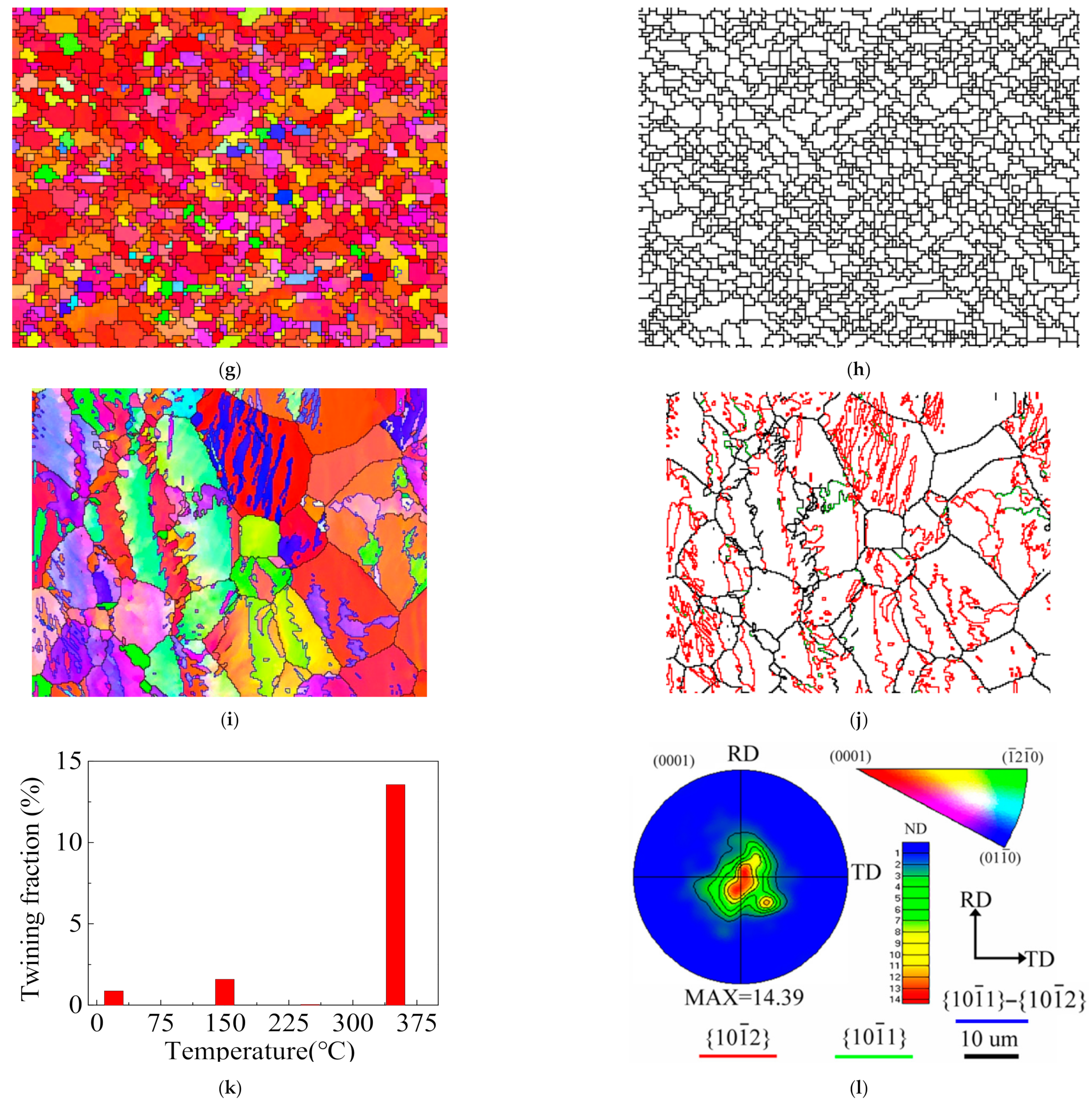
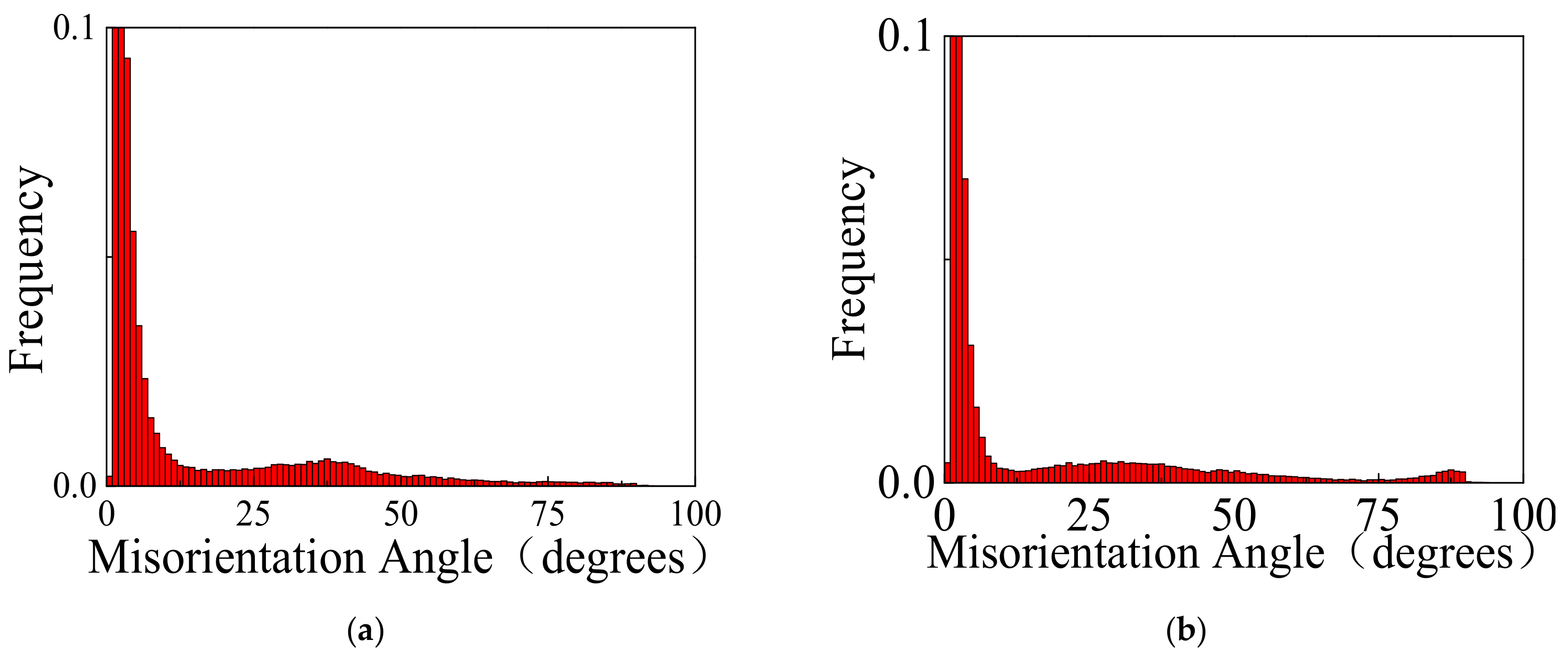
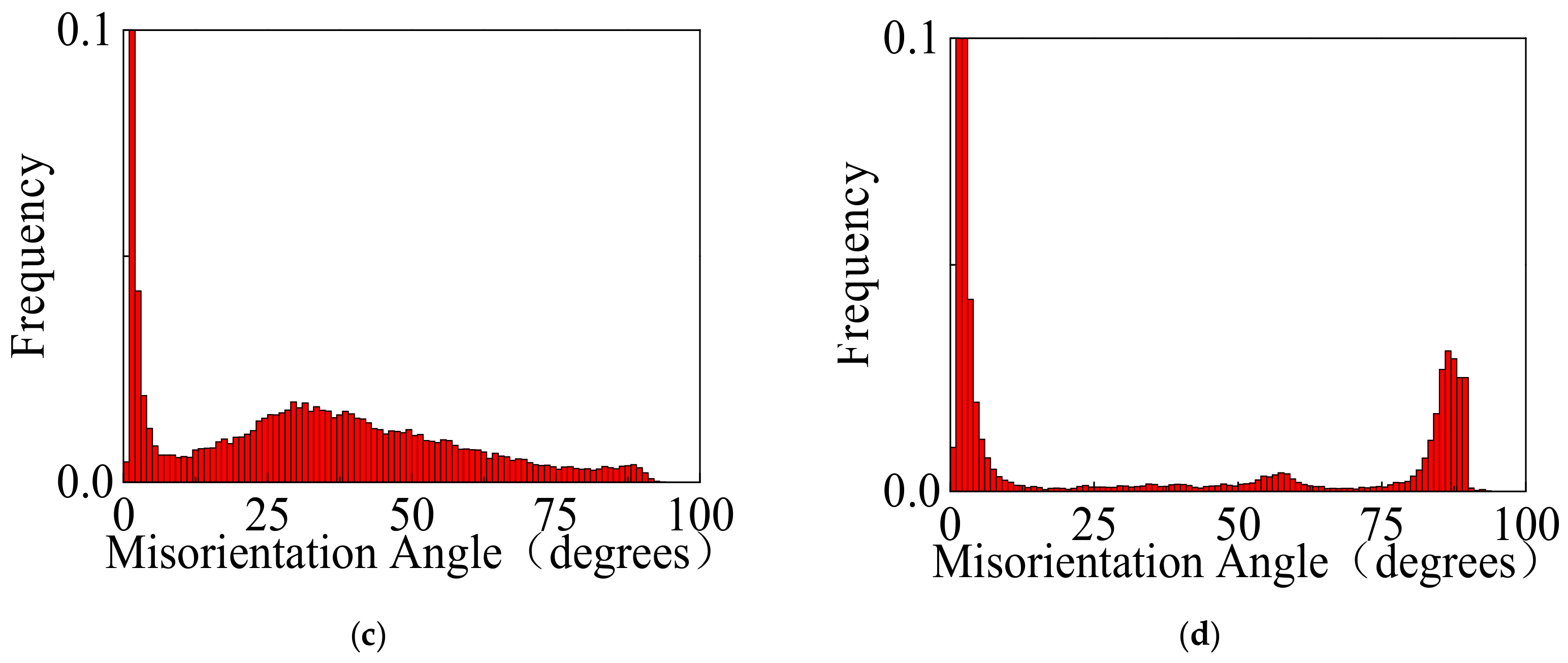
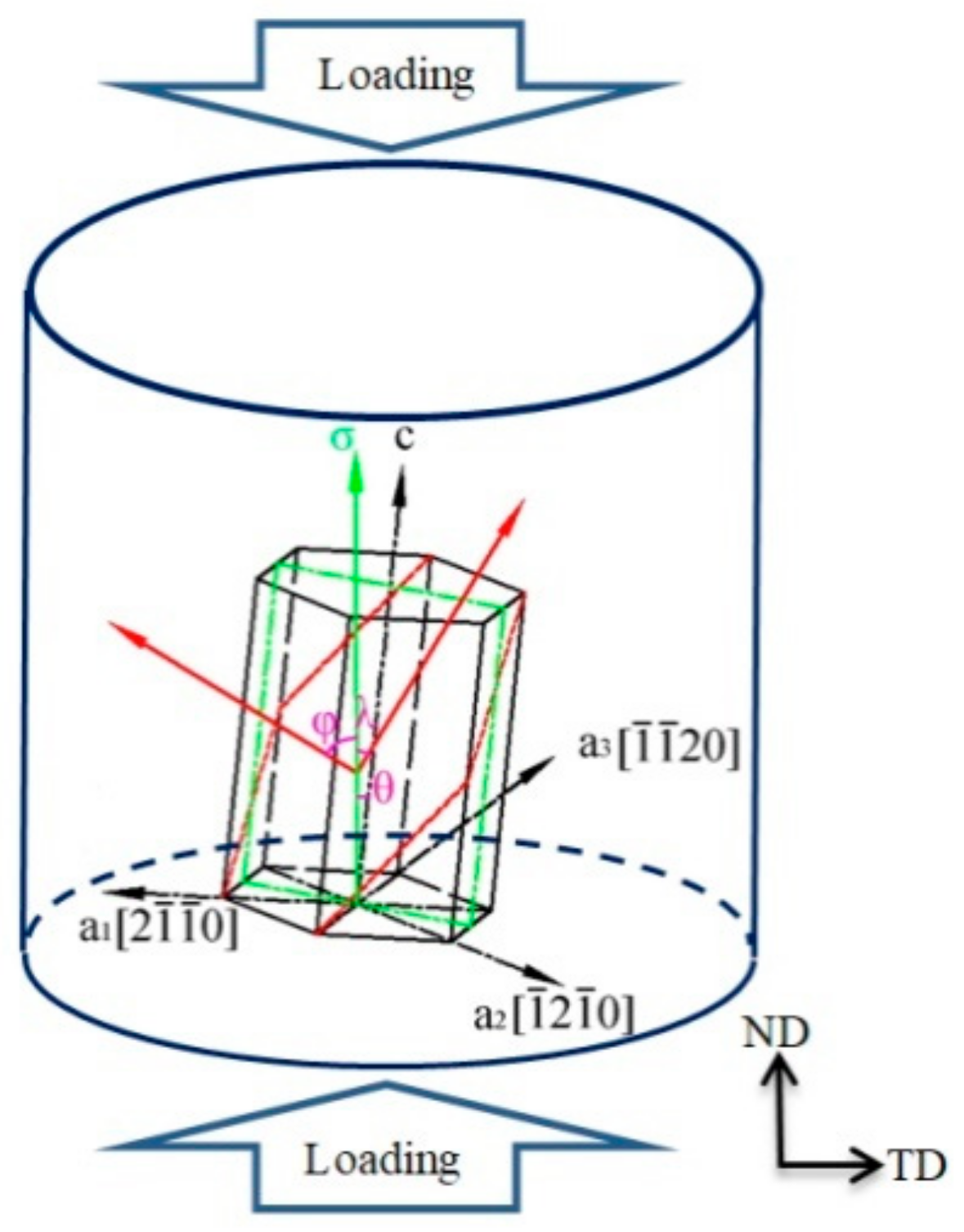
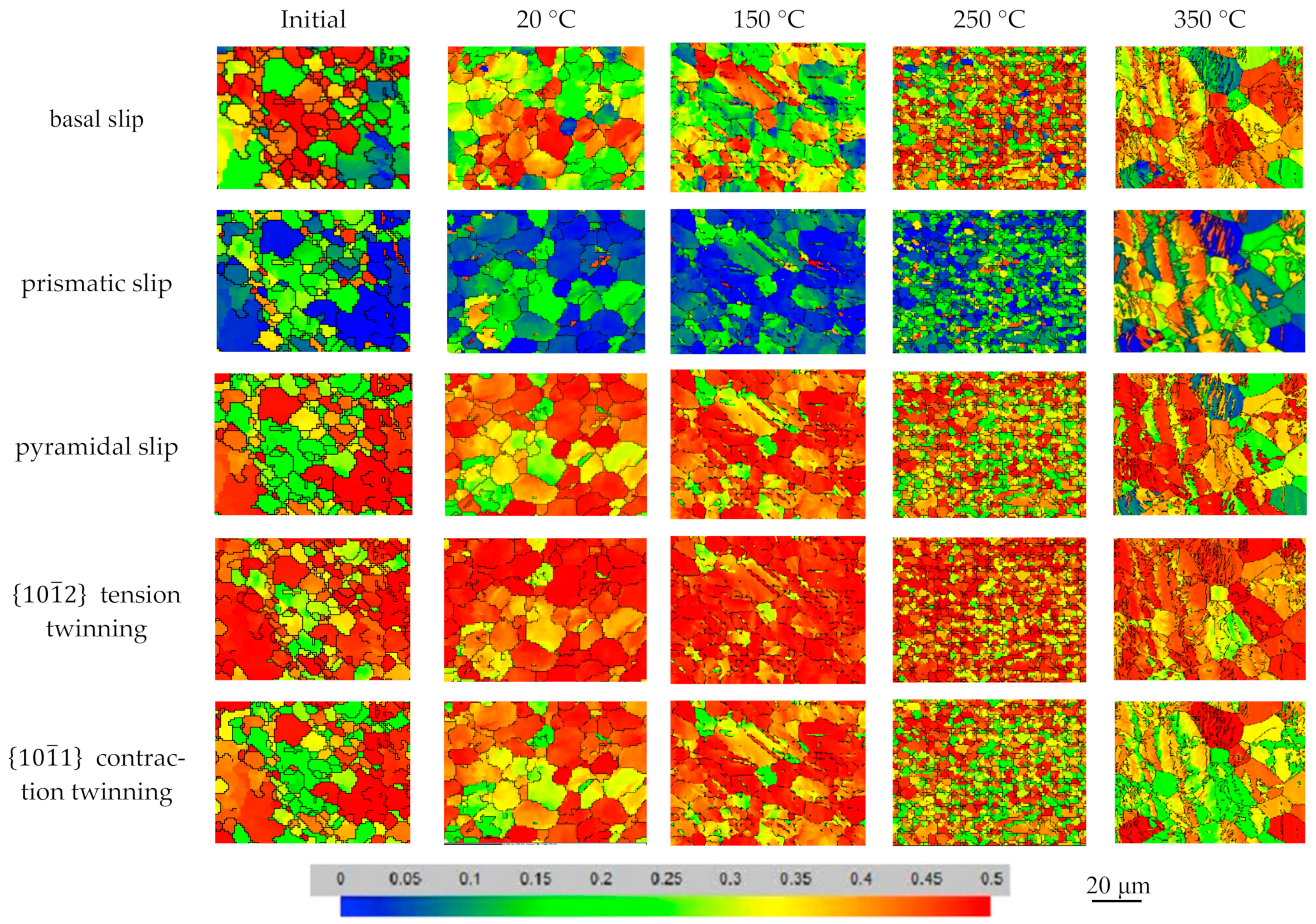
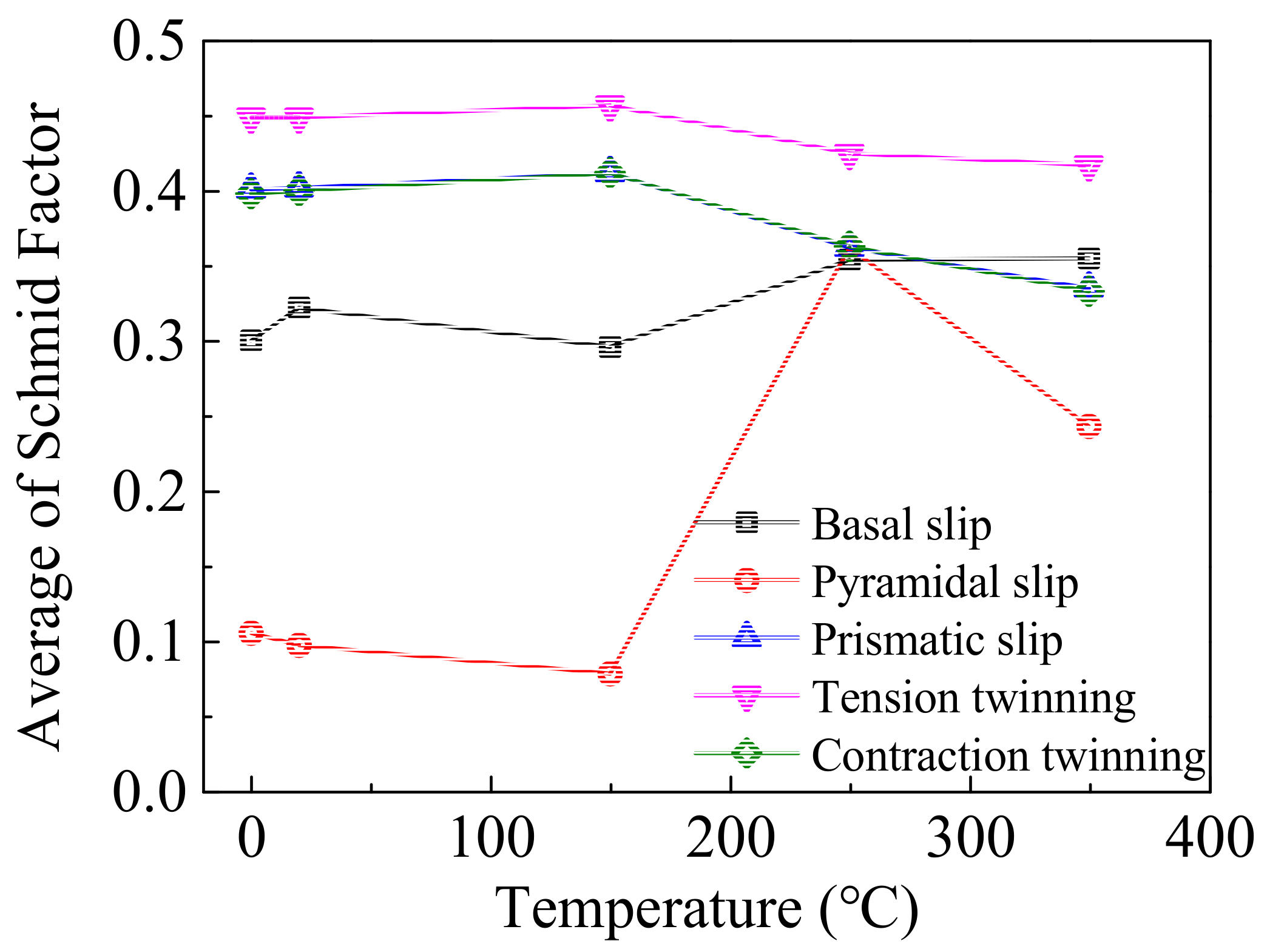
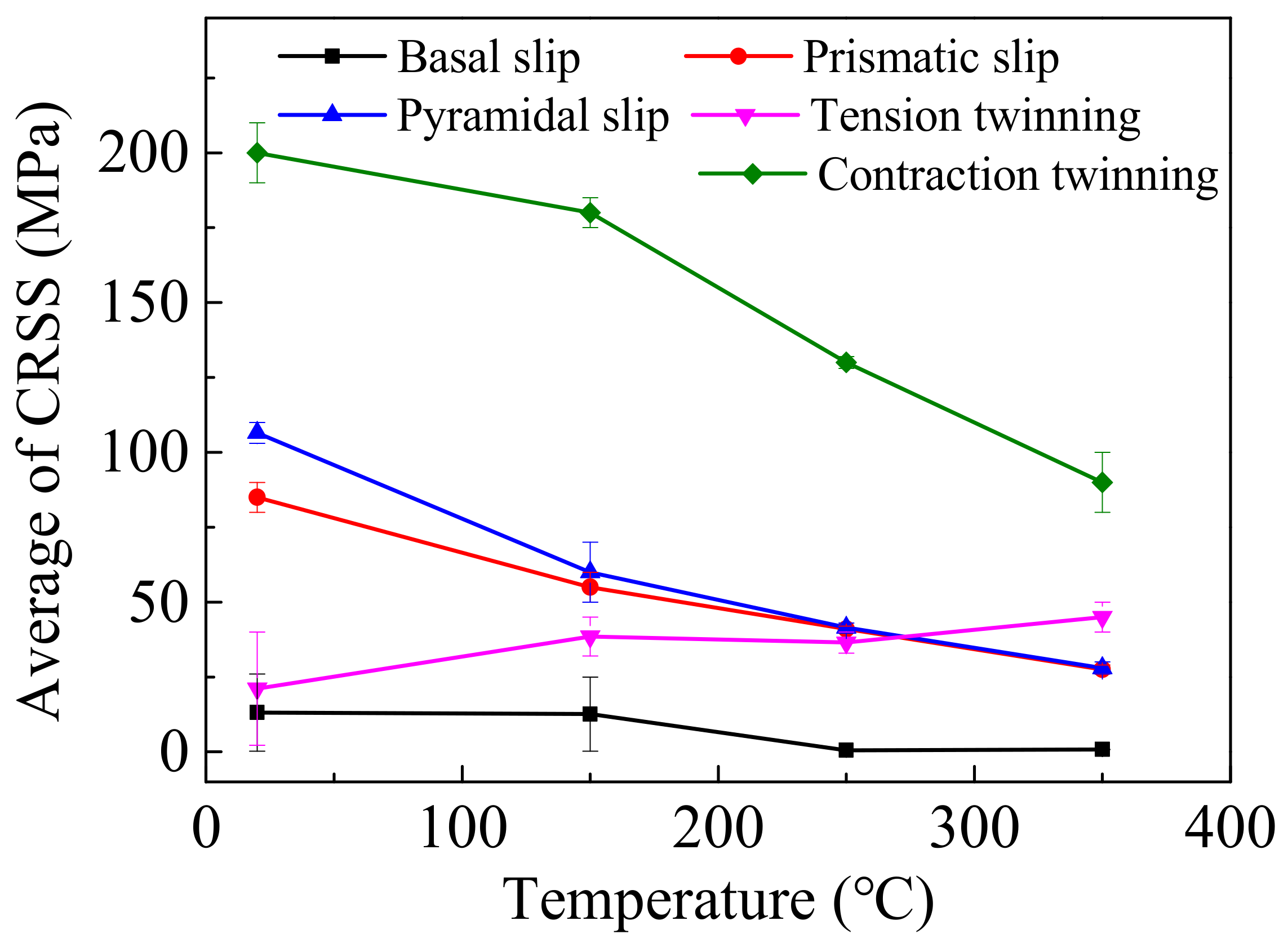


| Composition | Al | Mn | Zn | Fe | Si | Be | Cu | Mg |
|---|---|---|---|---|---|---|---|---|
| Content | 3.19 | 0.334 | 0.81 | 0.005 | 0.02 | 0.01 | 0.005 | Bal. |
| Deformation Mechanisms | Initial | 20 °C | 150 °C | 250 °C | 350 °C |
|---|---|---|---|---|---|
| basal slip | 0.3 | 0.322 | 0.296 | 0.354 | 0.355 |
| prismatic slip | 0.105 | 0.097 | 0.078 | 0.362 | 0.243 |
| pyramidal slip | 0.401 | 0.402 | 0.412 | 0.362 | 0.335 |
| tension twinning | 0.449 * | 0.449 * | 0.457 * | 0.425 | 0.417 |
| contraction twinning | 0.398 | 0.4 | 0.412 | 0.363 | 0.333 |
| Deformation Mechanisms | 20 °C | 150 °C | 250 °C | 350 °C |
|---|---|---|---|---|
| basal slip | 0.2–26 | 0.2–25 | 0.2–0.81 | 0.2–0.8 |
| prismatic slip | 80–90 | 50–65 | 40–42 | 26–29 |
| pyramidal slip | 103–110 | 50–70 | 40–43 | 26–38 |
| tension twinning | 2.2–40 | 32–45 | 33–40 | 40–45 |
| contraction twinning | 190–210 | 175–185 | 128–132 | 80–100 |
| Deformation Mechanisms | 20 °C | 150 °C | 250 °C | 350 °C |
|---|---|---|---|---|
| basal slip | 21–61 | 22–64 | 1–2 | 2 |
| prismatic slip | 851–902 | 673–737 | 112–115 | 110–116 |
| pyramidal slip | 261–269 | 133–158 | 113–117 | 87–104 |
| tension twinning | - | - | 82–90 | 99–105 |
| contraction twinning | 488–513 | 431–443 | 355–361 | 255–285 |
Publisher’s Note: MDPI stays neutral with regard to jurisdictional claims in published maps and institutional affiliations. |
© 2021 by the authors. Licensee MDPI, Basel, Switzerland. This article is an open access article distributed under the terms and conditions of the Creative Commons Attribution (CC BY) license (https://creativecommons.org/licenses/by/4.0/).
Share and Cite
Zhang, F.; Sun, M.; Sun, B.; Zhang, F.; Bai, Y.; Liu, Z. Temperature Dependency on the Microscopic Mechanism in the Normal Direction of Wrought AZ31 Sheet under Dynamic Compressive Behavior. Materials 2021, 14, 7436. https://doi.org/10.3390/ma14237436
Zhang F, Sun M, Sun B, Zhang F, Bai Y, Liu Z. Temperature Dependency on the Microscopic Mechanism in the Normal Direction of Wrought AZ31 Sheet under Dynamic Compressive Behavior. Materials. 2021; 14(23):7436. https://doi.org/10.3390/ma14237436
Chicago/Turabian StyleZhang, Feng, Mingcheng Sun, Baojie Sun, Fengzheng Zhang, Yikui Bai, and Zheng Liu. 2021. "Temperature Dependency on the Microscopic Mechanism in the Normal Direction of Wrought AZ31 Sheet under Dynamic Compressive Behavior" Materials 14, no. 23: 7436. https://doi.org/10.3390/ma14237436





